Installing split bamboo fencing yourself saves significant money on labor costs while using affordable materials that last 15-20 years. You’ll only need basic tools like a hammer, drill, and tape measure to complete the project. DIY installation gives you complete design control to mix patterns, create gradients, or combine different bamboo types for unique effects. Plus, bamboo is environmentally sustainable, growing rapidly and absorbing more CO₂ than hardwoods. The following guide will transform your outdoor space naturally and economically.
Cost Benefits of DIY Bamboo Fence Installation
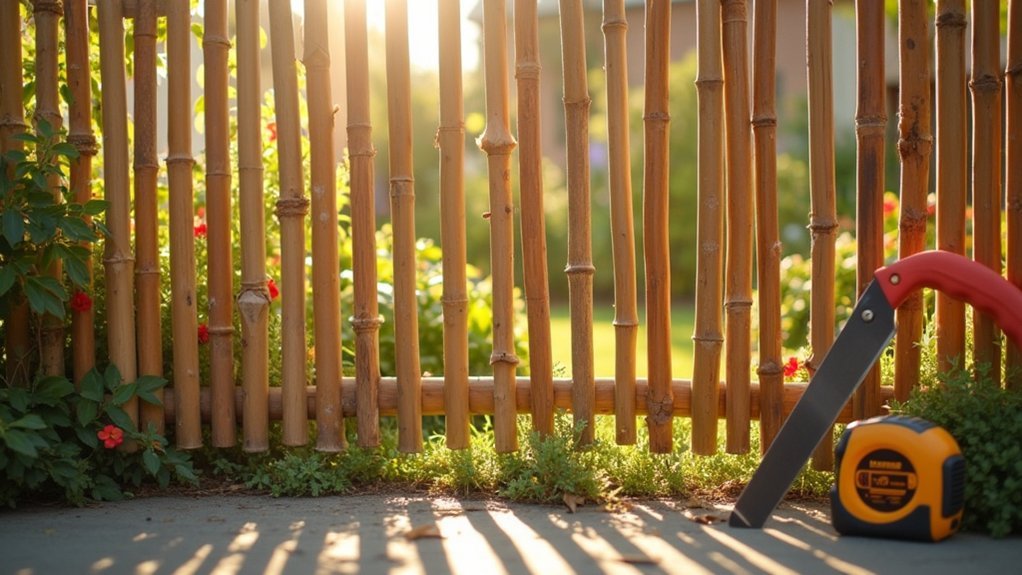
While many homeowners shy away from fence installation projects, installing split bamboo fencing yourself offers considerable financial advantages.
Bamboo material costs considerably less than traditional wood options, and by handling the installation, you’ll eliminate professional labor fees entirely.
You won’t need special permits or expensive equipment—just basic tools you likely already own. DIY installation kits available online provide all necessary materials at affordable prices, often with special value offers. Forever Bamboo offers a variety of sustainable bamboo products for both residential and commercial applications. The modular, simple design makes the work straightforward and quick.
DIY bamboo fencing requires only basic tools and affordable kits that make installation a breeze.
Long-term savings continue after installation. Bamboo fencing lasts 15-20 years with minimal maintenance, and its natural pest resistance eliminates the need for chemical treatments.
Tools and Materials Needed for Your Split Bamboo Project
You’ll need a specific set of tools and materials for your split bamboo fence project, ranging from basic equipment like shovels and hammers to specialized items such as countersink drill bits.
Consider cost-effective alternatives like renting the cordless drill or powder actuated tool rather than purchasing them outright.
With your complete checklist in hand, you can accurately budget for all necessary supplies while identifying which items you already own versus those you’ll need to acquire.
Pre-drilling holes approximately every 12 inches will help you avoid breaking the bamboo during the installation process.
Essential Equipment Checklist
Before beginning your split bamboo fence installation, gathering all necessary tools and materials will save you countless trips to the hardware store and guarantee a smooth project from start to finish.
You’ll need basic tools like a spade, hammer, drill, power screwdriver, and tape measure for accurate work.
For materials, gather bamboo fence panels, wooden posts (four-by-four-inch), two-by-four lumber for framing, and concrete mix for setting posts.
Don’t forget fasteners: three-inch wood screws, deck screws, cable ties, and galvanized wire for securing everything properly.
Protect yourself with working gloves and safety goggles.
Also have on hand a level, trowel, bucket for mixing concrete, and clippers for trimming.
A ladder will help you reach higher sections of your fence installation.
Consider purchasing pre-assembled panels in 6-foot by 6-foot dimensions for easier installation and consistent appearance.
Budget-Friendly Tool Options
Installing a split bamboo fence doesn’t require breaking the bank on expensive equipment. You’ll need basic tools like a hammer, drill, tape measure, handsaw or machete, and protective gloves to handle the sharp bamboo edges safely.
For splitting bamboo, consider making a DIY splitter from threaded rod and scrap metal rather than purchasing specialized equipment. A simple mallet can help drive the splitter through stubborn nodes.
When it comes to fastening materials, wood screws (2.5″ and 3″) offer secure attachment, while nails provide a cheaper alternative. Support your fence with affordable 4×4 posts and 2×4 lumber for framing, or use scrap wood to reduce costs further. When selecting screws, choose self-drilling screws for easier installation through the dense bamboo material.
Pre-cut bamboo panels can save time, though raw bamboo poles from local sources might be more economical if you don’t mind the preparation work.
Step-by-Step Installation Process for Beginners
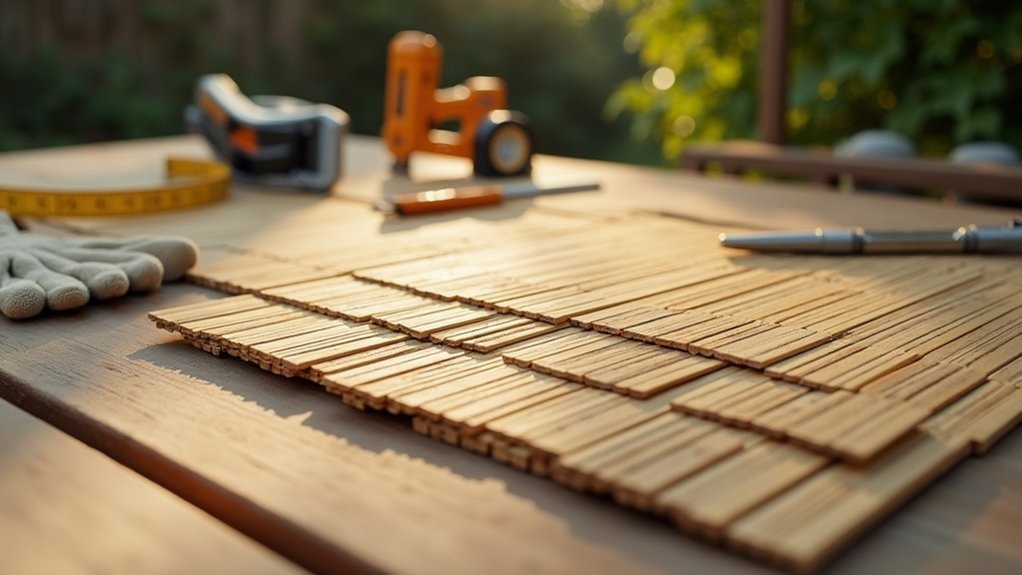
Setting up your own bamboo fence might seem intimidating at first, but with the right preparation and approach, it’s a manageable weekend project.
Begin by unrolling your bamboo fencing across the installation area, ensuring it’s properly aligned.
Next, prepare your posts by cutting them to appropriate lengths, considering both depth requirements and proper placement. To prevent cracking, pre-drill holes in the bamboo before inserting screws.
Secure your fencing to existing structures or posts using wire or screws, maintaining consistent tension throughout. Install with the cap ends up to prevent water from collecting inside the bamboo poles. If you’re using natural bamboo, remember to suspend it at least 2 inches from the ground to prevent water damage.
As you work, constantly check that your fence remains level.
For specific settings like brick walls or chainlink fences, adapt your attachment method accordingly using wire, netting clips, or eyelets.
Common Mistakes to Avoid When Installing Bamboo Fencing
Even with careful planning, many DIY enthusiasts encounter preventable pitfalls that compromise their bamboo fence’s integrity and appearance. Choosing non-durable bamboo for outdoor use often leads to premature decay, while improper attachment techniques like over-tightening or insufficient fasteners can weaken the entire structure. Ensuring you have the proper tools and materials for your specific fence type, whether it’s for chain link fences or others, will save you significant time and frustration.
| Mistake Type | Consequences |
|---|---|
| Poor material selection | Early deterioration, mismatched aesthetics |
| Inadequate site prep | Uneven installation, drainage problems |
| Improper attachment | Cracking, splitting, instability |
| Bad timing/conditions | Weather damage, premature aging |
| Regulatory oversights | Fines, required removal, neighbor disputes |
Don’t forget to check local building codes before starting your project. Pre-drill holes to prevent splitting, and verify your existing fence structure is sound before attaching bamboo. Remember that sustainable, certified bamboo not only looks better but lasts longer.
Weather-Proofing Your Split Bamboo Fence for Longevity

While bamboo fencing naturally possesses remarkable durability, proper weatherproofing remains essential for extending its lifespan beyond the typical 7-10 years.
Begin by thoroughly cleaning your fence with a detergent solution and allowing it to dry for at least 48 hours. Lightly sand surfaces to improve adhesion before applying oil-based stains that penetrate deeply into the bamboo.
Proper preparation creates the foundation for lasting protection—clean thoroughly, ensure complete drying, and sand lightly before staining.
Follow with 2-3 thin coats of spar urethane sealant, focusing on cut ends and joints where moisture intrusion is likely.
Don’t forget structural considerations—elevate your fence 1-2 inches above ground using gravel, install support poles every 8 feet, and use stainless steel screws for assembly.
Adapt your weatherproofing strategy to your climate, increasing sealant frequency in rainy regions and prioritizing UV protection in sunny areas. Regular inspection and maintenance will combat any small infestations before they compromise your fence’s integrity.
Creating Custom Designs With Split Bamboo Panels
You can create stunning visual interest by mixing different bamboo panel patterns within a single fence installation.
Try alternating horizontal and vertical slats to produce layered depth effects that make your fence appear more dimensional.
Combining dark and light-colored bamboo panels in a checkerboard or gradient pattern will further enhance your fence’s custom appearance while showcasing your personal style.
Available in various dimensions such as 1 D x 48 H x 96 L, our bamboo panels offer flexibility for almost any design concept you can imagine.
Pattern Mixing Possibilities
Split bamboo fencing offers remarkable versatility when it comes to creating custom designs for your outdoor space. You can create stunning gradient effects by combining different bamboo shades, perfect for blending with your garden’s color scheme.
Try mixing split bamboo with whole bamboo for textural contrast, or intertwine it with wire or metal for intricate patterns that catch the eye. For a contemporary look, arrange your bamboo in uniform linear patterns, or alternate vertical and horizontal panels for visual interest.
You’re not limited to standard designs—experiment with varying widths of bamboo rods for dynamic patterns.
For partial privacy with improved airflow, consider incorporating open sections in your design. The Four-Eyed Fence style provides an elegant solution with vertical pickets alternating between the front and rear of rails. The flexibility of split bamboo means you can adapt it to both curved and straight installations, perfectly fitting your unique landscape.
Layered Depth Effects
Creating dimension with split bamboo fencing transforms ordinary barriers into artistic installations.
You’ll discover remarkable visual depth by layering panels at various distances from walls or other structural elements. This technique creates shadows and textural interest that flat installations simply can’t match.
For maximum impact, consider staggering bamboo panels or creating a stepped appearance by setting some sections forward. The split bamboo poles lay flat against walls, creating rounded effects that enhance the dimensionality. You can enhance this dimensional effect by incorporating lighting behind or between layers, casting intriguing shadows that change throughout the day.
When you’re designing these layered installations, don’t forget that bamboo can be easily cut to your specifications.
This flexibility allows you to create custom patterns and depths that perfectly suit your space, whether you’re developing an indoor accent wall or an outdoor privacy screen with artistic flair.
Sustainable Benefits of Choosing Bamboo for Your Fence
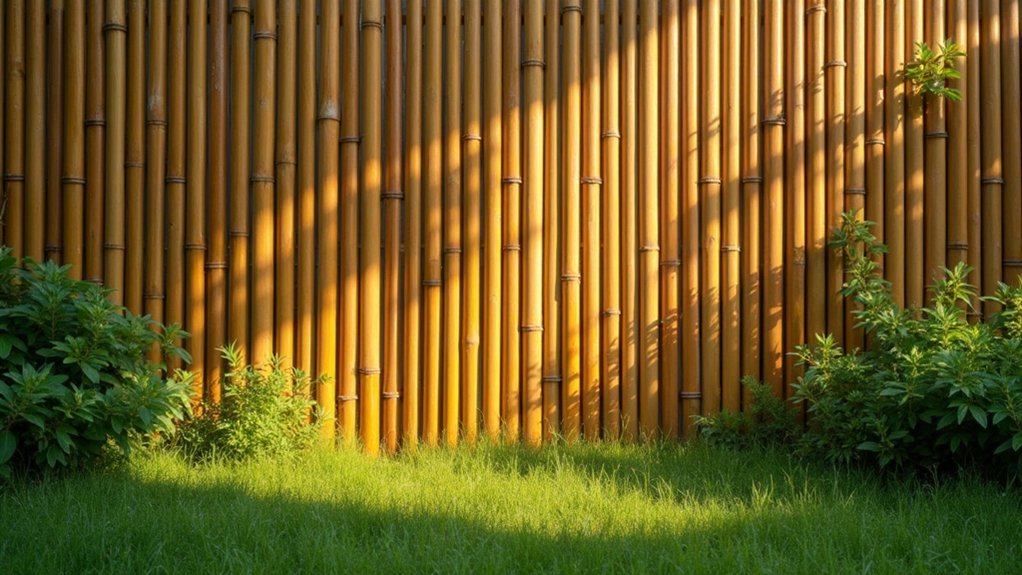
While many homeowners focus primarily on aesthetics when selecting fencing materials, bamboo stands out as an exceptionally eco-friendly choice with remarkable environmental credentials.
Unlike hardwoods that take decades to mature, bamboo grows up to three feet daily and can be harvested every 3-5 years without killing the plant.
You’ll contribute to carbon sequestration, as bamboo absorbs 35% more CO₂ than equivalent hardwood stands while releasing more oxygen.
Your bamboo fence requires considerably less water and energy to produce than wood or metal alternatives.
It’s naturally pest-resistant, eliminating the need for chemical treatments.
When your fence eventually reaches the end of its 10-20 year lifespan, it’ll fully decompose without toxic residue, creating a truly sustainable lifecycle from growth to disposal.
The impressive tensile strength of bamboo, comparable to steel at approximately 28,000 pounds per square inch, ensures your fence will remain durable against environmental stresses.
Maintenance Tips to Preserve Your Bamboo Fence Investment
Having invested in an environmentally responsible bamboo fence, you’ll want to protect that investment for years to come.
Start your maintenance routine one year after installation, then continue every 18-24 months.
Clean your fence with a detergent solution, let it soak for 15 minutes, and scrub with a nylon brush before allowing two full days to dry. Weather conditions should be checked in advance since two days of drying are necessary before applying any sealant.
Apply a thin coat of bamboo-specific sealant annually, followed by a second coat 24 hours later.
Inspect monthly for cracks, decay, or termite damage, especially at ground level.
Verify the fence base maintains 100mm clearance from soil.
Re-stain every 2-3 years to preserve appearance, and lightly sand rough patches to prevent splinters.
Trim nearby vegetation regularly to prevent damage from branches and roots.
Transforming Your Outdoor Space With Natural Bamboo Elements
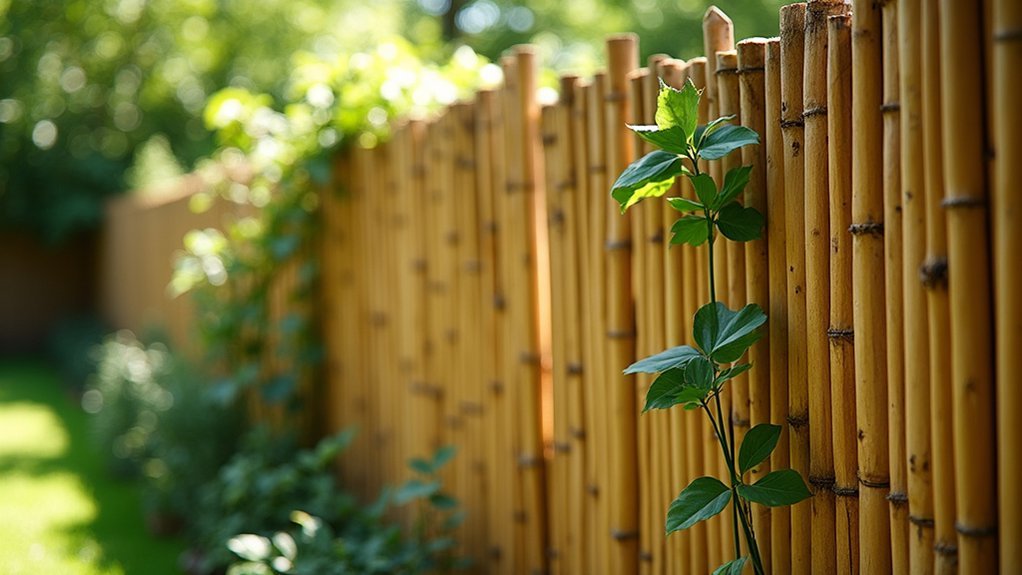
Beyond mere fencing, bamboo elements can transform your outdoor space into a serene retreat that reflects both style and environmental consciousness. The warm, natural tones and organic textures create an inviting atmosphere that complements any landscape design.
You’ll notice bamboo’s versatility extends far beyond basic borders—use it for screens, pergolas, or decking accents to create defined yet fluid zones for relaxation. Its gentle rustling adds a calming sensory dimension while strategically placed partitions filter light beautifully. Clumping bamboo varieties are particularly ideal for limited spaces in your front yard landscape.
What’s more, you’re making an eco-friendly choice. Bamboo grows rapidly, requires less energy to produce than conventional materials, and leaves a smaller carbon footprint.
As it ages, it develops a pleasing patina that enhances your garden’s character while embodying Wabi-Sabi principles of natural imperfection and tranquility.
Frequently Asked Questions
Can Split Bamboo Fencing Be Installed on Uneven Ground?
Yes, you can install split bamboo fencing on uneven ground. You’ll need additional post supports, proper ground preparation, and sectional installation techniques. Make certain you’ve got leveling tools and plan for water runoff afterwards.
How Does Bamboo Fencing Hold up Against Strong Winds?
Bamboo fencing holds up remarkably well against strong winds due to its natural flexibility. You’ll appreciate how the culms bend without breaking, allowing wind to pass through while the rounded design reduces pressure buildup.
Is Split Bamboo Fencing Safe for Homes With Pets?
Yes, split bamboo fencing is safe for pets when properly installed. You’ll need to secure it off the ground to prevent escapes and monitor pets who chew. It’s durable enough for most large dogs.
Can Bamboo Fencing Be Attached to Existing Fence Structures?
Yes, you can easily attach bamboo fencing to existing structures. It’s a versatile addition that works well with chain link, wood, or metal fences using zip ties, galvanized wire, or deck screws for secure fastening.
How Do Neighbors Typically React to Bamboo Fence Installations?
Neighbors often welcome bamboo fencing for its natural beauty, but you’ll need to manage growth and communicate your plans beforehand. Address privacy concerns and maintain your fence to prevent disputes over property boundaries.
In Summary
By installing split bamboo fencing yourself, you’ll save money while adding natural beauty to your property. You’ve now got the knowledge to select materials, install properly, and maintain your fence for years to come. Don’t forget to weatherproof and check regularly for damage. With a bit of DIY spirit, you’ve created a sustainable, unique outdoor space that reflects your personal style.

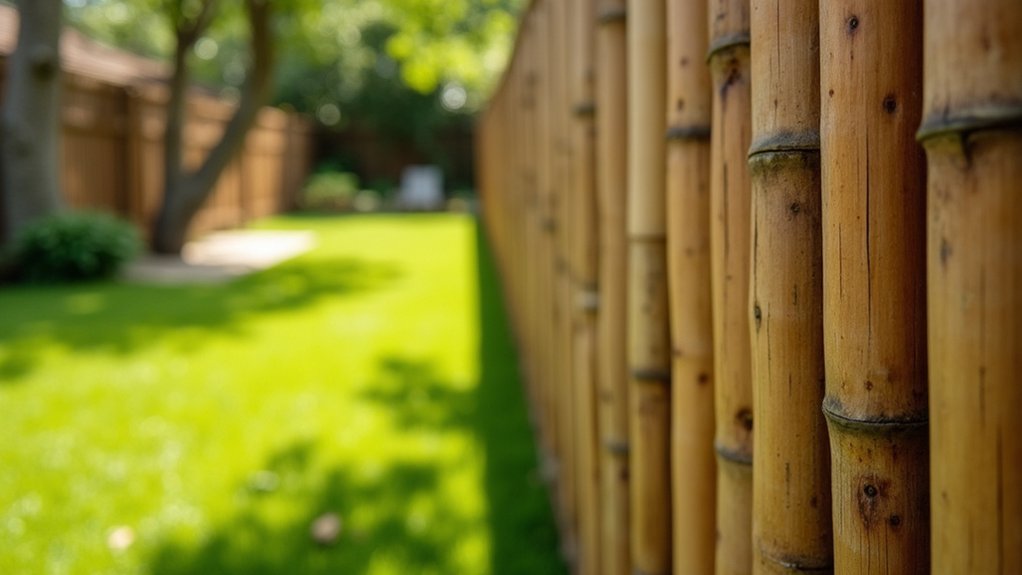



Leave a Reply